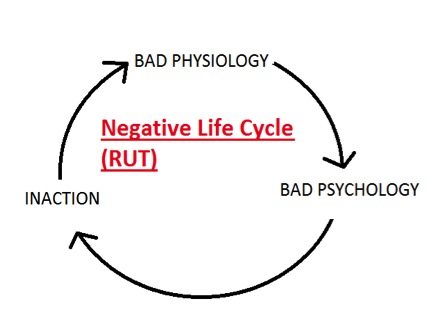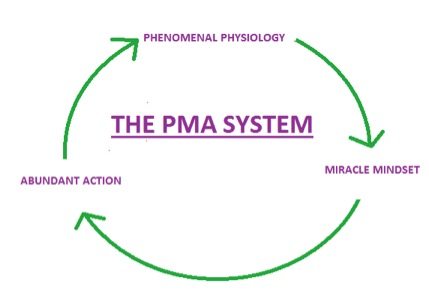Success Advice
The 3 Things YOU Need To Escape Your Rut

Most, if not all of my coaching clients and quite frankly anyone that I speak with can testify to being in or ‘near’ a rut of some kind. Be it their health and fitness, their relationships, their career; whatever it is, they are in one. The chances are so are YOU, but what is a rut?
A rut is where you are gaining little or no success, fulfilment or happiness from doing the SAME THINGS every single day! If it is your weight/body then you can’t get out of the ‘pattern’ of eating junk food, being lazy and not exercising. If it is in your relationships then you can’t get out of the ‘pattern’ of taking your loved ones for granted, communicating poorly and initiating no ‘spark’. If it is your career you likely feel ‘stuck’ in the rat race and you feel that you are going to a job that you don’t like every day just to ‘get by’.
And so it continues….

The Negative Life Cycle
It seems then that a rut can be defined as a ‘Negative Life Cycle’. The negativity just breeds more negativity and you can be left feeling like there is no escape. The real kick in the teeth is that ruts start to create new ruts and they create an increasingly steep negative spiral towards despair. For example, you feel down about being stuck in the rat race so you come in from work every day in a negative mood, carrying a whole lot of negative energy with you. This leads you to take it out on your spouse so they begin to feel rejected and react in the form of arguing. This arguing leads you to become even more down so you lose any life spirit and motivation to do anything so you stop exercising and start ‘comfort eating’.
All of a sudden you are left depressed at work, overweight and unhealthy with a marriage on the rocks. Sound familiar?
Why can’t you Escape?

To really change something it is important to understand it. Let’s go back to the beginning of the above scenario; I believe that there are 3 things happening and these are the ‘spokes’ on the wheel of the negative life cycle. Firstly, how you use and treat your body, bad days at work are causing you to move in a depressed way, which is leading you to make unhelpful pictures in your mind (e.g growing towards retirement age in a job you hate) and finally in this negative state of mind you are no place to do something about it. So then your spouse picks up this negative body language which leads them to question you, which leads to you making negative pictures in your mind (e.g them ‘controlling’ you), which leads to you removing yourself from the situation and not doing something about it. Do you see where this is going?
It is easy to see that if this continues for any prolonged period of time you have a pretty exact formula for being unhappy and unsuccessful.
The 3 parts of the Negative Life Cycle become ingrained. You become overweight (sometimes severely so), you are always making bad use of the words and pictures in your mind (you hate people, the world and everything in it) and you are now in the habit of inaction because you believe that it is just the way you are and you can’t change now anyway.
Escape Your Rut with the PMA SystemTM

In this Universe of ours, everything always has an opposite: Up and down, Left & Right, Hot & Cold. One simply could not exist without the other. It was upon my enlightenment to this phenomenon that I sensed that there must be people out there that are just as fulfilled, happy and successful as their rut dwelling counterparts are miserable, lost and unsuccessful. That led me to believe that they were doing exactly the opposite of people who are in a rut.
Hey Presto! I started changing people’s lives by really delving into how they treated and used their bodies, what pictures/self-talk they made in their minds and what action they took and so “The PMA SyestemTM” was born.
Do It Now!
If you are stuck in a rut in any area of your life, implement The PMA SystemTM NOW! Yes right now, not in 20 minutes not in 2 days, not in 3 weeks; you can get started RIGHT NOW. Let’s use your body/health as an example. If you are not happy with it create a Goal that would make you feel so phenomenal that you start to feel it right now, your breathing changes, your shoulders rise and you start to smile as you start to ‘see yourself’ as amazing as you know you can be (here is the Miracle Mindset kicking in already). Continue to hold on to that vision of yourself and what you will look and feel like. Feel grateful as if that is the body that you have already! Now it’s time for ACTION, and not just a little bit of action ABUNDANT ACTION!
Join a gym, plan your new healthy eating regimen, buy a workout DVD, go for a walk, and set your alarm for an hour earlier tomorrow morning. It is easy to see how you can rapidly set the wheels in motion so you are living in a positive way where good things keep happening. There are many applications for the PMA system, both in a second by second environment and also in the formation and realisation of longer term goals.
Life
10 Research-Backed Steps to Create Real Change This New Year
This New Year could finally be the one where you break old patterns and create real, lasting change.

Every New Year, we make plans and set goals, but often repeat old patterns. (more…)
Change Your Mindset
The Silent Skill That Makes People Respect You Instantly
What truly earns respect and why most people go about it the wrong way

Everybody craves respect but not everyone earns it. Some people believe that a title, years of experience, or a position of authority automatically entitles them to respect. (more…)
Entrepreneurs
The Essential Skills Every Entrepreneur Needs In 2026
Success in the digital age isn’t about luck. It’s about mastering the skills that separate dreamers from doers.

When I was 22 years old, I started my first side hustle as a ghostwriter. (more…)
Did You Know
The Success Patterns You Inherited (And Didn’t Notice)
Your family history may hold the key to why you think, act, and feel the way you do today.

Who are you? Your experiences and your family’s narratives and legacies contribute to your identity. Your ancestry contains individual traits and forces that have been inherited over the years. It also carries the fights and victories of your forebears and older family members. (more…)
-

 Personal Development4 weeks ago
Personal Development4 weeks agoThis Silent Habit Might Be Sabotaging Your Career
-

 Business3 weeks ago
Business3 weeks agoWhy Your E-Commerce Fulfilment Is Probably Broken (And How to Fix It)
-

 Shift Your Mindset3 weeks ago
Shift Your Mindset3 weeks ago11 E’s That Define Every Great Leader And Why Most People Miss Them
-

 Did You Know2 weeks ago
Did You Know2 weeks agoThe Success Patterns You Inherited (And Didn’t Notice)
-

 Business3 weeks ago
Business3 weeks agoThe Hidden Money Pit in Your Operations (and How to Use It)
-

 Entrepreneurs2 weeks ago
Entrepreneurs2 weeks agoThe Essential Skills Every Entrepreneur Needs In 2026
-

 Change Your Mindset1 week ago
Change Your Mindset1 week agoHow to Turn Your Mind Into Your Greatest Asset (Instead of Your Enemy)
-

 Change Your Mindset6 days ago
Change Your Mindset6 days agoThe Silent Skill That Makes People Respect You Instantly



























4 Comments